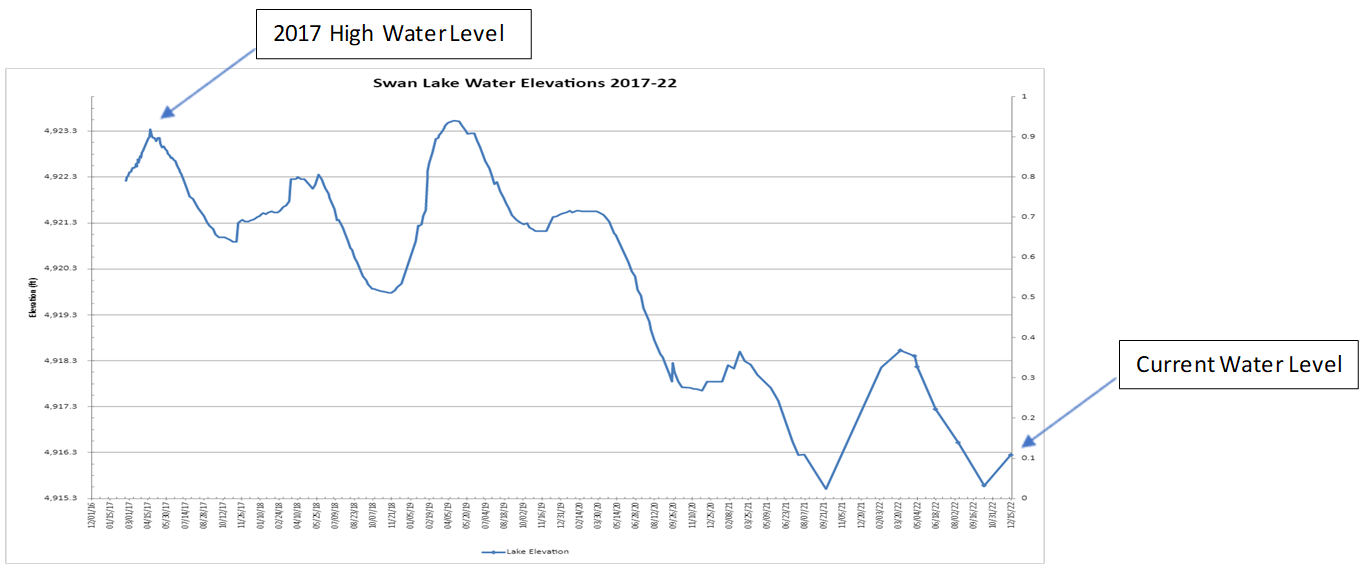The year is coming to a close in a way that is reminiscent of 2016, when multiple heavy rain storms resulted in significant flooding. We understand that there is fear and apprehension, but we want residents to know that we are not in the same position now as we were then. Currently the amount of water in Swan Lake is less than 20 percent of what it was in 2017, and over all the total amount of water in Swan Lake is about 10 percent of what it was at its most recent highest level (2017).
Swan Lake is the lowest place within the Lemmon Valley “closed basin,” meaning all precipitation and snowmelt moves to the lake. As with every previous winter, Washoe County anticipates the water level to rise with heavy rain and snow. Over the last five winters the average increase in lake levels has been between 1 and 3 feet, and if the weather patterns continue the lake will still be significantly lower than what we experienced in 2017.
As you look at the water level data, you can see the anticipated downward trend of the amount of water in Swan Lake. This “stair step” reduction shows the winter gains from precipitation and the summer losses from evaporation. It also shows visually the overall water level declines from the record setting peak in 2017 to where we are today.
How we got here:
After the flooding early in 2017, Washoe County and its regional partners developed various emergency response measures specific to Swan Lake and Silver Lake. We inspect the area regularly, we monitor lake water levels, and review potential threats when large regional storms are forecast. Washoe County will not hesitate to enact emergency provisions to maintain open roadways for the benefit of the residents and service providers.
As we do throughout the county, our field staff monitor Lemmon Valley and check on known problem areas in the weeks and days leading up to a storm, clearing culverts of trash and sediment.
Since 2017 we have spent more than $10 million on flood-fighting efforts in Lemmon Valley alone. We continue our commitment and are ready to respond if the lake begins to rapidly rise and threaten the safety of our community. In 2017, Washoe County established a webcam to live-stream the Swan Lake water level. You can view that live webcam here. Today when you visit the lake or view it through the Lake Cam live feed, it is immediately evident that the lake is nowhere near as high as it was in December 2016. But there is always a flood threat no matter where you live and no matter what time of year it is. That’s why we continue to monitor lake elevations and take regular measurements, review weather forecasts and precipitation patterns, perform field inspections of the storm water infrastructure (drainage channels, cross pipes, roadside ditches, etc.) and are prepared to respond should we see rapidly rising lake levels.
Questions that we expect to be asked as we head into a wet winter:
Q: Will Swan Lake water levels increase over the winter?
Yes, but we don’t anticipate levels anywhere near the record setting high water mark experienced in 2017. While Swan Lake is the bottom of the Lemmon Valley hydrobasin and rain and snow melt drains to the lake, the water levels are about 10% of the levels when compared to 2017. But if water levels suddenly rise to higher levels threatening the safety of the community, Washoe County will initiate flood responses to maintain open roadways and access for residents and emergency service provides.
Q: The HESCO barriers were to keep water off the road. Why’d you remove them? Don’t we need them now?
The HESCO barriers served their purpose and were removed when the risk of flooding dropped to a point that the barriers were no longer needed. After they were removed, extensive repair work to the impacted roads and ditches was done, thereby restoring the safe movement of storm water away from roadways, assuring safe passage for residents and emergency responders.
Q: I see weeds in the ditch by my house. Why don’t you clear those out?
Weeds growing in the ditches should be expected and will not significantly impede the drainage system. In some cases, the roots of the weeds will keep the ditches from eroding. Overgrowth of weeds should be reported, but weeds in and of themselves will not clog drainage.
Q: Will pumps be reinstalled along Lemmon Drive?
Pumps were used for a specific purpose while the lake level receded. They are no longer an appropriate tool to keep water off the roadway but would be reinstalled if water levels rose high enough to warrant their use.
Q: Why is water pooling in some areas and draining in others?
In Lemmon Valley, the topography is extremely flat, so depending on the amount of rain and runoff, some roadside ditches convey water at a much slower rate than others. Rising water within the ditch system is to be expected. We are fully aware of this, and it is not considered a problem when it happens.
Q: What can I do to protect my property?
Pick up garbage and keep the ditches and pipes clear of large debris. Household garbage, garbage cans and lawn debris can be problematic and can clog drainages but can easily be removed by property owners. If your property is prone to flooding, utilize the sand and sandbags made available by Washoe County. For questions or to report low supply of sand or sandbags, please call 775-328-2180.
Washoe County’s Community Service Department is made up of residents from all areas of Washoe County. We’re your neighbors, and we face the same concerns when we see heavy rain in the forecast. We remember 2016-2017 and we are working hard to keep roads clear and avert flooding as much as possible.

